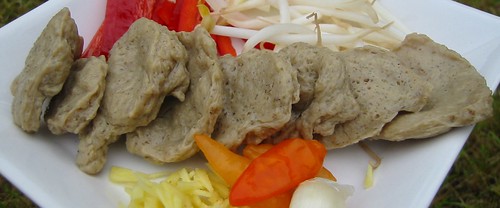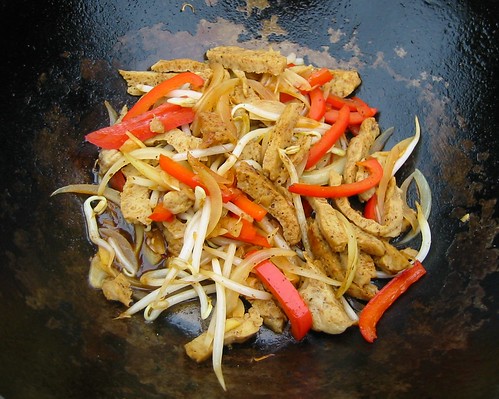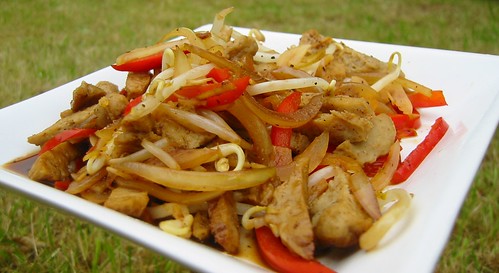
Seitan is one of those foods that occupy an uneasy position in the world. Is it a traditional food or is it food technology gone mad? Like soya it has expanded beyond its historical culinary origins into a food that tries to carry itself on its tradition but is often so far removed from it that any resemblance to the original is purely coincidental. It is no longer the aesthetic flowering of stringent temple cookery but a commodity in a protein greedy world.
I like seitan sometimes. It's good in a stir fry, can be used to emulate Peking duck for eating with pancakes and plum sauce, makes a change as a protein booster from the inevitable pulses but it's only one food of many and the tradition of imitating meat products with it puts it in a context that as a vegan I would sometimes prefer to avoid.
It's not an easy option to obtain either in France or the UK. We used to buy small tins of it from the Chinese supermarket - made in Taiwan they came in an interesting variety of flavours and forms from abalone to popk (sic) taking in duck and chicken along the way. They all taste much the same but the abalone is in small puffs, the chicken and duck have scary feather pimples moulded into their solid slices and the popk is a slightly more lurid pink. Unfortunately, after various food scares from China and other oriental producers we've become reluctant to buy this any more, just in case.
With that sort of ambivalance in mind we managed perfectly well but finally, after doing without for some time I decided that I had to give it a go myself. The technique isn't complicated, just a bit physical and tedious and others had tried and succeeded, like my friend Herbi (who has documented the process so well I've borrowed his photos, see the full set here) so what could possibly go wrong?
Looking around the web for recipe ideas I found that the traditional method has all but been superseded by the quick and easy route, commercially extracted gluten powder is juggled around casually by all sorts of cooks and it's become something of a vegan staple recipe for many - of which more later - but I was looking for the old fashioned sort.
My first hurdle was that nearly all the recipes call for wholewheat flour. Why is that when the whole point of the exercise is to remove from the wheat everything but the protein? I resolved to use white flour and be damned. I put 1.5kg strong white bread flour into the mixer and added 950 ml. of water. This is the proportion I use for making bread, more or less, and it gives a fairly tight dough which I thought would be a good start for the process. Unfortunately our huge bread mixer found the quantity too small for a proper beating. I had no more white flour so another 1.5kg wholemeal swiftly followed the white into the bowl along with more water.

I set the controls for the heart of the sun and sat back to wait. Twenty minutes later I had a large lump of dough. So far, so good. Then, I started to get cold feet! All that water used, all that carbohydrate and bran washed away. In my research earlier I saw only one commercial concern that mentioned recovery of these items and I vaguely remember from years ago an amateur recommendation to collect and dry the starch (effectively gluten free flour) for other uses but that was not visible on my searches today. This is such a wasteful food.

The actual washing is a pleasant enough task, a bit like washing your undies in the sink. To begin with the ball of dough collapses into claggy strings but after about the fourth change of water it starts to come back together again and form a sturdy squishy sponge that can be pulled and pressed with impunity to get it clean from the milky flour water.
After a great deal of kneading, squeezing and water down the drain you'll be left with about third of what you started with - you've extracted the gluten, nearly pure protein although there is still a lot of water in it.

To complete the process you need to cook it. I've seen recipes that suggest a short plain water simmer before adding it to a stock for a longer cooking but I don't think that this is necessary for small pieces.
Make a big (for this amount I had 6 litres of stock) pot of stock, using your favourite powder, fresh vegetable stock, dried herbs etc and add to it quite a lot of soy sauce, a strip of kombu and a few slices of root ginger. When it comes to the boil add your gluten in pieces. I found the best way to do this was to take handfuls of the stuff, stretch and squeeze it into thin sausage shapes and then use scissors to snip off thin sections. These expand in the pot, taking up the flavour of the stock and become quite neat looking slices. Allow to simmer gently for an hour and then turn off the heat, cover the pot and allow to cool in the pan.
Use immediately, store in a covered container in the fridge with some of the stock for up to a week or freeze in small containers, again with some stock, and use fairly quickly.

It is an interesting food but achieved at the cost of throwing the baby out with the bathwater; at the same time as making this experiment with gluten I used the equivalent ingredients (with the addition of a little yeast) to make six loaves of bread. A few slices of that will give you all the same protein properly rounded out with carbohydrates and fibre, far less water usage and not a lot of difference in the energy used for cooking.
I made a tiny stir fry to illustrate this blog post and I expect to showcase the seitan more fully over the coming weeks. It is a good protein addition to the diet but the high processing costs associated with it mean that it should be regarded as a special occasion food, a luxury for high days and holidays. The effort required to make it is the indicator of that.
And this is why I view with some reserve the many current recipes on the web using vital gluten powder. In my view, the possibly misguided search for foodstuffs that are nutritionally comparable to meat is causing vegans to fall into the same trap as the meat eaters. The food is becoming overprocessed and resource heavy, unsustainably concentrated and the link to a more natural, healthy diet is becoming lost.

11 comments:
You're so right. What a palaver!
When I buy 'vital wheat gluten', do you know what the commercial makers do with the washed away flour? If it goes to good use, like gluten-free flour, I won't feel so wasteful! I lived in Japan for some time, and love seitan, and also make it from scratch. Usually the 'quick' way using the VWG.
mym - I won't be making it for your dinner then!
anna - I don't know what the commercial manufacturers do but without any authority whatsoever I would guess that they trim their processes and recover anything that can be sold on profitably so are resource conscious to an extent even if for the wrong reasons.
Thanks for visiting.
So I attempted to make seitan last week, knowing there were no commercial products available here. (Oh, to have an American hfs nearby where I could buy seitan and tempeh and such already made!)
Anyway, it was not a success. I boiled the broth, which expanded the seitan to almost the consistency of bread. I'm going to toss it all and start again, having just ordered a new batch of gluten from the US. I've made a seitan/tofu roast for holidays, and it is much better.
I am pro-seitan, and pro-meaty-type products, simply because I believe they contribute to non-veggies conversions to veg-ism. And the waste is hardly equivalent to that of a meat based diet, so I'm fine with a little wastefulness now and then.
But thanks for the advice, and I'll definitely check out your resources before I try again!
Hi Kathy,
It is possible to buy tempeh in the UK. We get it from our local health food co-op, I'm sure there's something local to you too. If not a trip to Brighton will give you Infinity Foods, worth the trip alone and Brighton is always fun for a day out.
http://www.infinityfoodsretail.co.uk/
There is also Goodness Direct
http://www.goodnessdirect.co.uk/
who do mail order and have tempeh, Redwood and Fry's meat substitute products. I have used them and they are o.k. although you have to check the sell by dates carefully. They will replace anything that is wrong but it's irritating to have to ask them.
I know what you mean about using these products as a gateway to encourage new adopters of the vegan diet - I suppose I'm just very much against a lot of processing in food.
I've managed to find tempeh at one or two stores, but it's not as good as the tempeh in the states. White Wave makes a five-grain tempeh which isn't as "beany" as the soy-only tempeh. It's very good. If you ever go to the US try some.
I'm not sure I'll ever go to the States again but the man is there at the moment. I'll text him!
The reason whole wheat flour is used is because you'll get a higher yield (more seitan) because there is more gluten in whole wheat than in commercial "white" flour. Hard red wheat has a very high gluten content.
The only water I have access to is from a hand-dug well (now that was some hard work!) and captured rain-water. Even living in a very dry area with hot hot hot long summers, I still have more water than money so buying vital wheat gluten to avoid the "work" of making seitan from scratch is out of reach for my budget.
I'm astounded at how much water people use for this process. Such waste. Whatever happened to making an extremely stiff dough (no kneading necessary) and soaking it overnight in cool/cold water? The next day, I knead for a short bit in the soaking water. Drain, then refill the bowl and squeeze the dough between my fingers, feeling for the small hard whitish lumps. All it takes is manipulating the lumps out with my fingers, draining again and one more final "wash" and that's it. That's three whole bowls of water.
As to the spongy bready texture of the cooked seitan - here are some tips to avoid that.
- When cooking the washed dough, start in cold water then bring the temperature up to a simmer.
- What really helps is to roll the washed dough into a fat log shape and then wrap it *tightly* in heavy duty foil (or use a double layer of regular foil). Twist the ends of the foil so that you end up with something that looks like a giant tootsie roll. That will greatly reduce the spongy texture that so many object to.
Hopefully this helps someone.
Thanks Samantha.
I should point out for the avoidance of confusion that the wholemeal-ness or otherwise bears no relation to the protein content of the flour, it is entirely a product of the type of grain used.
As you point out hard red wheat is known for its high protein content but any wheat flour described as suitable for making bread will have enough protein to make gluten.
The bran which remains in wholegrain flour is essentially cellulose, a complex carbohydrate and adds nothing material to the gluten content.
I wish there was comment editing...
>>any wheat flour described as suitable for making bread will have enough protein to make gluten. <<
should read, of course
"any wheat flour described as suitable for making bread will have enough protein to make seitan."
Thank you for the thought-provoking post. I have seen the Vital Wheat Gluten everywhere and had falsely assumed it was the positive by-product. I have been increasingly concerned with the super-processed 'vegan' versions of everything from butter to cheese and meats. Do you know about the processing involved in making Daiya?
Post a Comment